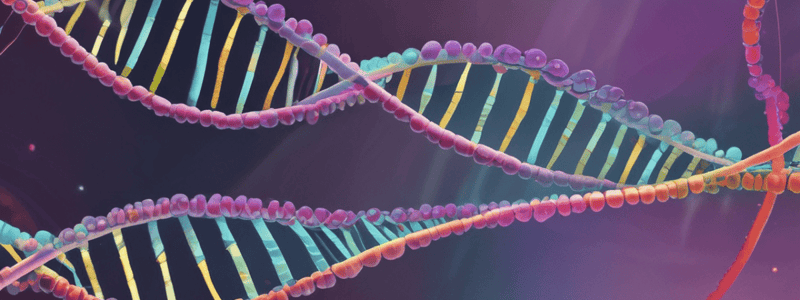Podcast
Questions and Answers
What is the consequence of a mistake in base pairing during DNA replication?
What is the consequence of a mistake in base pairing during DNA replication?
- Formation of additional cell organelles
- Permanent cessation of cell function
- Genome mutation, which may affect daughter cells (correct)
- Increased DNA replication speed
What activity does DNA polymerase use to remove an improper nucleotide?
What activity does DNA polymerase use to remove an improper nucleotide?
- 3' to 5' exonuclease activity (correct)
- Helicase activity
- 5' to 3' exonuclease activity
- Ligase activity
What can happen if DNA replication errors are not repaired in germ cells?
What can happen if DNA replication errors are not repaired in germ cells?
- Immediate cell death
- Enhanced immune response
- Inherited diseases (correct)
- Cell repair initiation
Which strand is excised and repaired during mismatch repair?
Which strand is excised and repaired during mismatch repair?
What mechanism do eukaryotes use to differentiate between the new and old DNA strands during repair?
What mechanism do eukaryotes use to differentiate between the new and old DNA strands during repair?
Why does DNA polymerase stall during the addition of nucleotides?
Why does DNA polymerase stall during the addition of nucleotides?
Flashcards are hidden until you start studying
Study Notes
DNA Replication: When Things Go Wrong
- Maintaining base pairing rules is crucial, as mistakes can lead to genome mutations and consequences for daughter cells
- Correct nucleotide pairings are essential for fitting in the polymerase active site
- If an incorrect nucleotide is incorporated:
- Polymerase uses its proofreading ability to cleave the phosphodiester bond of the improper nucleotide
- The correct nucleotide is added, and the process continues in the 5' 3' direction
- Failure to repair mistakes can lead to:
- Inherited diseases in germ cells
- Cancer in somatic cells
Mis-pairing and Proofreading
- 3' to 5' Exonuclease activity of DNA polymerase I is used to correct mis-pairing
- During nucleotide addition, the correct incoming nucleotide is aligned with the catalytic groups
- Incorrect Watson-Crick base pairing causes kinetic stalling, initiating proofreading repair
DNA Replication - DNA Repair
Uncorrected Replication Errors
- Three possible outcomes:
- No repair
- Excision and repair of only the template (old) strand
- Excision and repair of only the newly synthesized strand
Mismatch Repair
- Enzyme complex recognizes mistakes, excises the newly synthesized strand, and fills in the correct pairing
- Eukaryotes use nicks to label the daughter strand, distinguishing it from the old strand
Studying That Suits You
Use AI to generate personalized quizzes and flashcards to suit your learning preferences.




